Notice
Please be aware that Hestercombe will be closed on Christmas Day and Boxing Day, but will be open daily throughout the rest of the Christmas holidays.
MEMORIES OF HESTERCOMBE: THE 1873-77 REMODELLING OF HESTERCOMBE HOUSE
Please be aware that Hestercombe will be closed on Christmas Day and Boxing Day, but will be open daily throughout the rest of the Christmas holidays.
The moulded stone arch that frames the east entrance to the Gallery Shop, originally the Great Hall, probably formed part of the rear wall of the original, early medieval house at Hestercombe. By the late 17th century the increasingly substantial residence of the Warre family contained 27 hearths, bringing about a levy of 27/- for a half-year's hearth tax in 1664-65, the second largest total in the county. Enlarged again by Sir Francis Warre (1659-1718), probably in the 1680s to designs by William Taylor, a London country house architect who was then much in demand in Somerset – he worked at Orchard Portman, Taunton (Sir William Portman MP), Halswell, Goathurst (Sir Halswell Tynte) and Chipley Park, Wellington (Edward Clarke MP) amongst others -- Hestercombe House was eventually recorded in a large oil painting of 1700, now lost. A drawing made from the original painting, which hung in the Great Hall for generations, shows a medieval house on the left and an early classical front to what is now the west block. Projecting from its centre is a two storey porch with balustraded balcony, the entrance door below set in a concave niche reminiscent of William Taylor’s work at Halswell. The House itself is approached through an enclosed gated 'Green Court' before which lie three buildings: a thatched Elizabethan dovecote; an orangery/greenhouse built c.1683 by Sir Francis Warre (now the Bampfylde Hall); and the Warre family chapel, demolished 1766.
Sir Francis Warre continued to improve Hestercombe House up until his death in December 1718. In 1717 the ‘Old Parlour’, probably part of the medieval solar that once adjoined the south side of the Great Hall, containing the private living and sleeping quarters of Sir Francis and his ancestors, was repurposed as a dining room. Sash windows, a new floor, plaster ceiling and 160 yards of wainscoting (wood panelling) were installed, with additional payments being recorded in the spring of 1718 for fresh curtains, sconces (wall mounted candle holders), and a marble chimney surround by James Paly of Bristol.
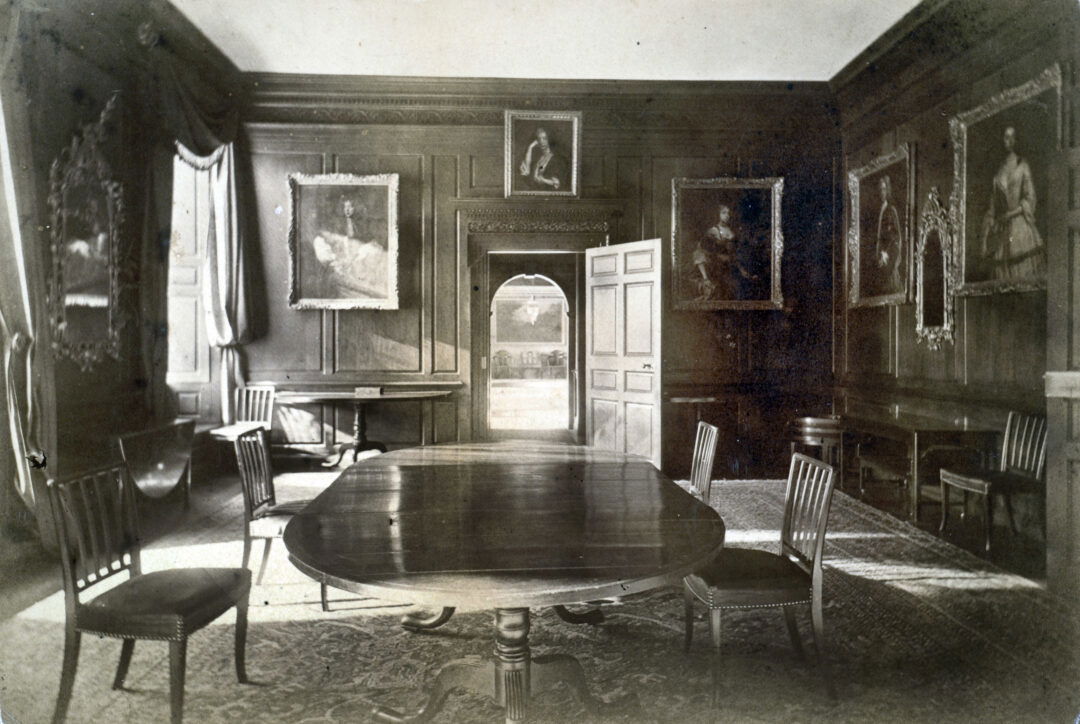
However, the most significant changes to be made to Hestercombe House during the 18th century were commissioned by Sir Francis’s son-in-law and successor, John Bampfylde (1691-1750). Between 1719 and 1732, at a cost in excess of £1,200 (£295,000 today), Bampfylde removed the northwest wing and part of the south annex and renewed the west block in the Palladian manner. A classical ordering of sash windows, diorite surrounds, and neatly coursed diorite was employed and substantial payments made to William Parker, joyner (£740-07-04), Mr. Newick (£44-13-0), George Bailey (£341-04-06), and Freeman the Glazier (£69-00-00) amongst others. The reddish hard-to-work diorite stone was quarried in the valley behind the House. By the time of Bampfylde’s death on 17 September 1750 the principal rooms of the House were seventeen in number, namely: The [Great] Hall (now The Gallery Shop), The Passage, The Dining Parlour, The Great Parlour (now The Column Room), The Hall Gallery, Mr. C.W. Bampyfylde's Room, The Long Gallery, Best Room, Mrs. Bampfylde's Room, Mrs. Bampfylde's Dressing Room, Mrs Bampfylde's Closet, Mr. Bampfylde's Dressing Room, Mrs Pollard's Room, Miss Bampfylde's Room, Captain Malet's Room, Beer Cellar and Ale Cellar. ‘Mrs. Bampfylde’ was Margaret Warre (1694-1758), only daughter and heir of Sir Francis Warre who married John Bampfylde, ‘Mr. Bampfylde’, of Warleigh, Devon on 18 October 1718 in the Warre family chapel. ‘Miss Bampfylde’ was Frances Bampfylde (1723-56), second daughter of John and Margaret Bampfylde and ‘Captain Malet’ was Captain John Malet of the Royal Navy, Margaret Warre’s bachelor cousin. Mrs. Pollard was probably a servant (housekeeper?).
--------------------------------------------------------------------------------------------------------------------------
THE INTERIOR ARRANGEMENTS,
Being in every way suited to the requirements of a large establishment, are as follows, viz :--
Entrance Hall, with vaulted roof, 43 feet 6 inches by 21 feet 6 inches, and Music Gallery at end.
Drawing Room, 21 feet 3 inches by 15 feet 9 inches, and 13 feet 9 inches high (exclusive of Bay Window), with inlaid Marble Chimney Piece, and Stencilled Walls.
Dining Room, 30 feet 6 inches by 22 feet, and 13 feet 9 inches high, with Polished Oak Floor, Panelled Walls and Massive Oak Moulding to match, and Marble Chimney Piece.
Study, 19 feet 8 inches by 15 feet 8 inches, with Oak Floor and Marble Mantel Piece, large Recess and Passage leading to small Room, fitted with shelves and pigeon-holes for papers.
Morning Drawing Room, 25 feet 6 inches by 17 feet 4 inches, with richly embossed Ceiling.
Ante-Room adjoining , and small Store Room.
Back-Hall and Vestibule, w.c. and Two Store Closets.
ON THE FIRST FLOOR
(Approached by a broad Winding Staircase),
Are Four Bed Rooms, of the following dimensions respectively : - 19 feet by 16 feet 9 inches, with Marble Chimney Piece and Cupboard; 21 feet by 18 feet 6 inches; 16 feet by 14 feet 3 inches; 15 feet 9 inches by 15 feet; and Two Dressing Rooms.
Opening to the Back Gallery are Four well-proportioned Bed Rooms, with Cupboards, Two Dressing Rooms and Store Room; and in the North Wing, with separate Staircase, are Two Bed Rooms and Bath Room, with hot and cold water supplies.
ON THE SECOND FLOOR,
With Stairs leading from basement, are Ten Secondary Bed Rooms and Attics, small Room and Closet.
THE DOMESTIC OFFICES ARE IN THE BASEMENT,
AND COMPRISE
Servants' Hall, fitted with Cupboard and Benches, Housekeeper's Room, with Store Cupboards, Kitchen fitted with Cooking Range, Crane and Oven, Hot Plate Cooking Copper and Brick Oven,
Cook's Room, Scullery, Dairy, Larder, Butler's Pantry, Back Pantry, Wine and Ale Cellars,
------------------------------------------------------------------------------------------------
Particulars and Conditions of Sale . . . Residential Manorial Estate known as Hestercombe . . . which will be sold by Auction by Messrs. Beadel at the Mart, Tokenhouse Yard, London 6 August 1872, p. 2.
Unlike his father, Coplestone Warre Bampfylde (1720-91), made few alterations to the mansion after inheriting Hestercombe in 1750 and it would remain largely unchanged until 1874 when it was renovated by its then owner of two years, Edward Berkeley, 1st Viscount Portman (1799-1888) of Bryanston, Dorset. Lord Portman had acquired the estate in August 1872 for £63,500 (£55,000 for the buildings and 776 acres of land, plus £8,500 for the timber), a figure that translates into £7,235,000 in modern money. The vendor, Alexander Hugh Baring, 4th Baron Ashburton, was the grandson of financier, Alexander Baring, 1st Lord Ashburton and onetime MP for Taunton, who in 1823 had acquired the reversionary interest from C. W. Bampfylde’s great niece, Miss Elizabeth Maria Tyndale Warre (1791-1872). ‘Careful in the extreme’, Miss Warre had only ever undertaken essential work to the House which was now seriously in need of extensive repairs and modernisation.
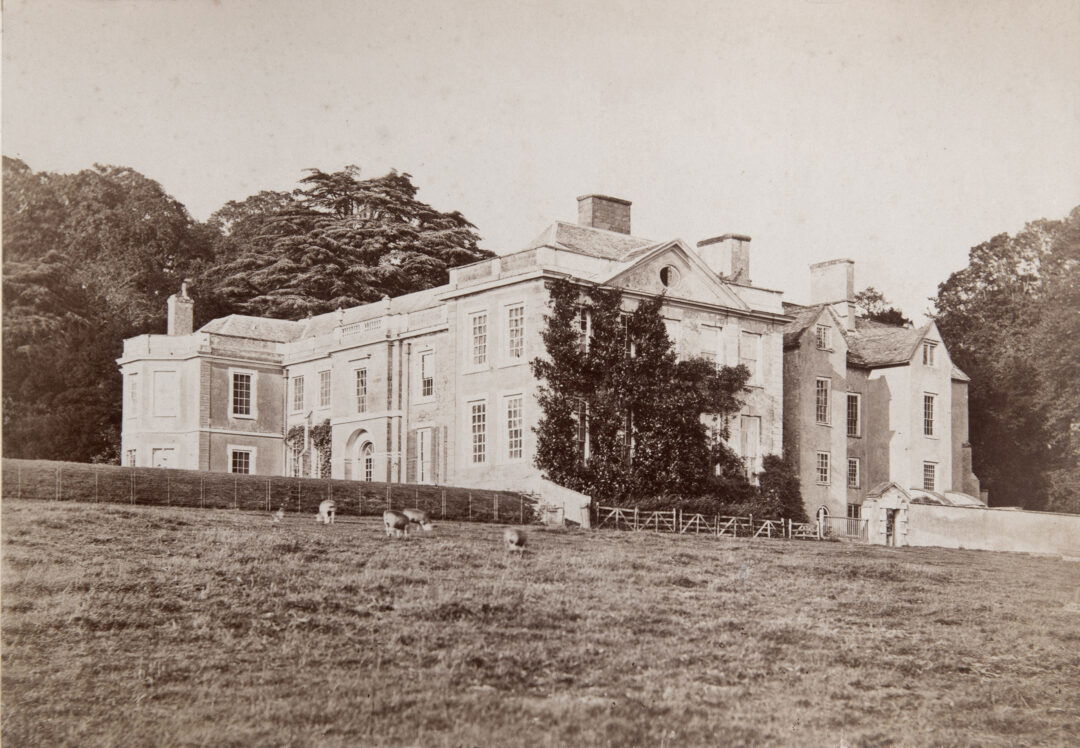


Consequently, in January of 1873 London based architect, Henry Hall (1829-1909), who had established ‘a large and comfortable’ country practice, primarily in Somerset and Dorset, was contracted by Lord Portman to make designs 'for a first class mansion’. Hall, who was said to bear a close resemblance to Lord Salisbury ‘both in features and build’ was held in high esteem by his peers. In his obituary (RIBA Journal, 4 December 1909) he was described as a ‘fine old English gentleman . . . tremendously hard-working and industrious . . . the soul of honour and absolute integrity’. A practicing architect of thirty years, Hall appeared eminently qualified, having compiled a varied portfolio of completed works that included municipal buildings, churches, schools, mansions and houses, banks and even hospitals. According to the Taunton Courier (22 August 1877, p. 6), Lord Portman, who had already had the House photographed for posterity and was soon to commission a comprehensive written history of the Warre family (The Chronicle of the Warres, 1879) instructed Hall ‘that the external appearance of the house was to be kept as far as possible and the old hall, with the minstrels' gallery, dining-room, morning-room and business-room, were to be preserved'
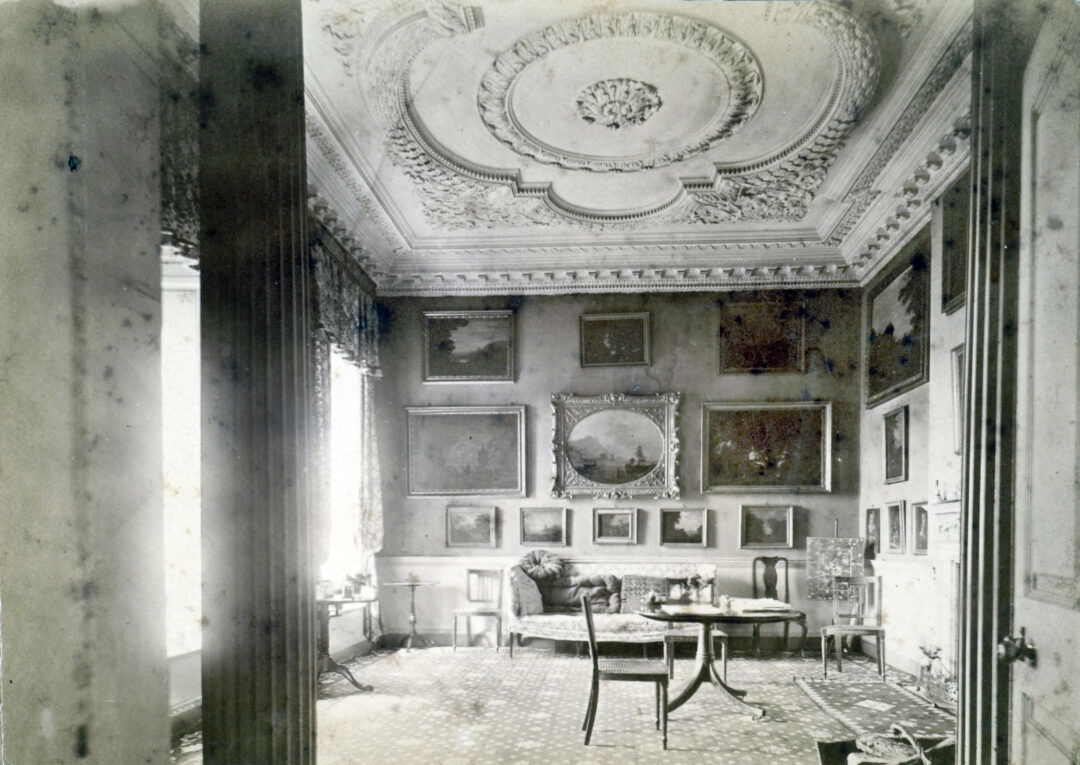
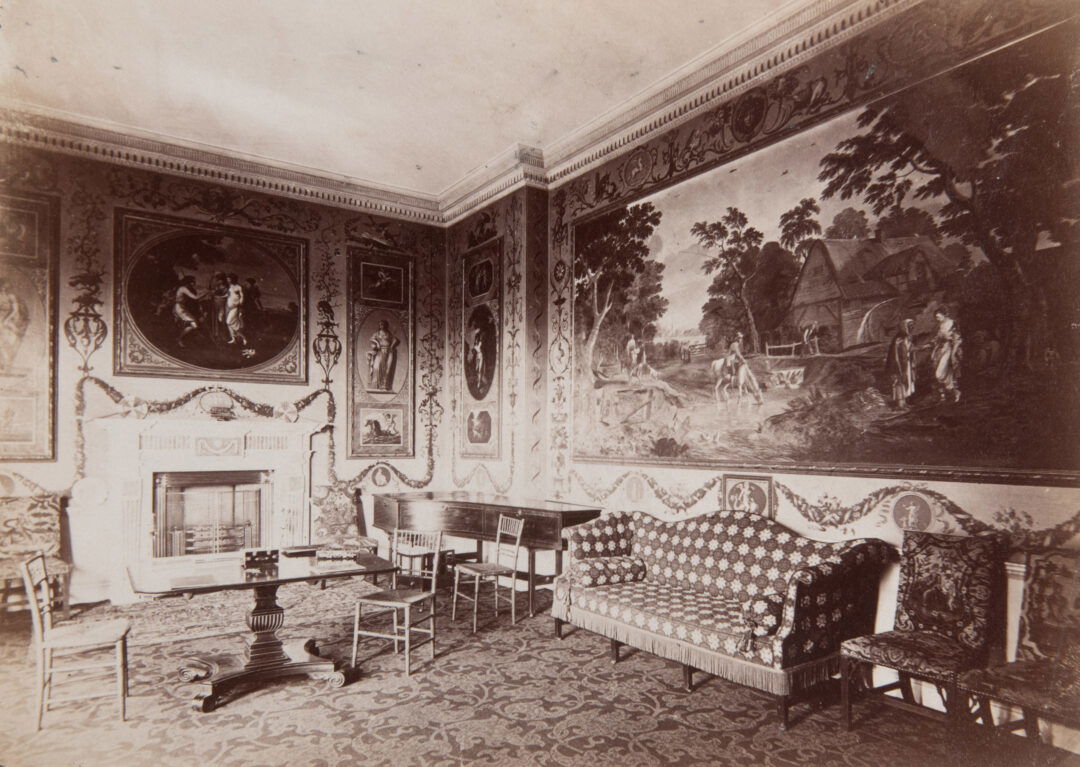
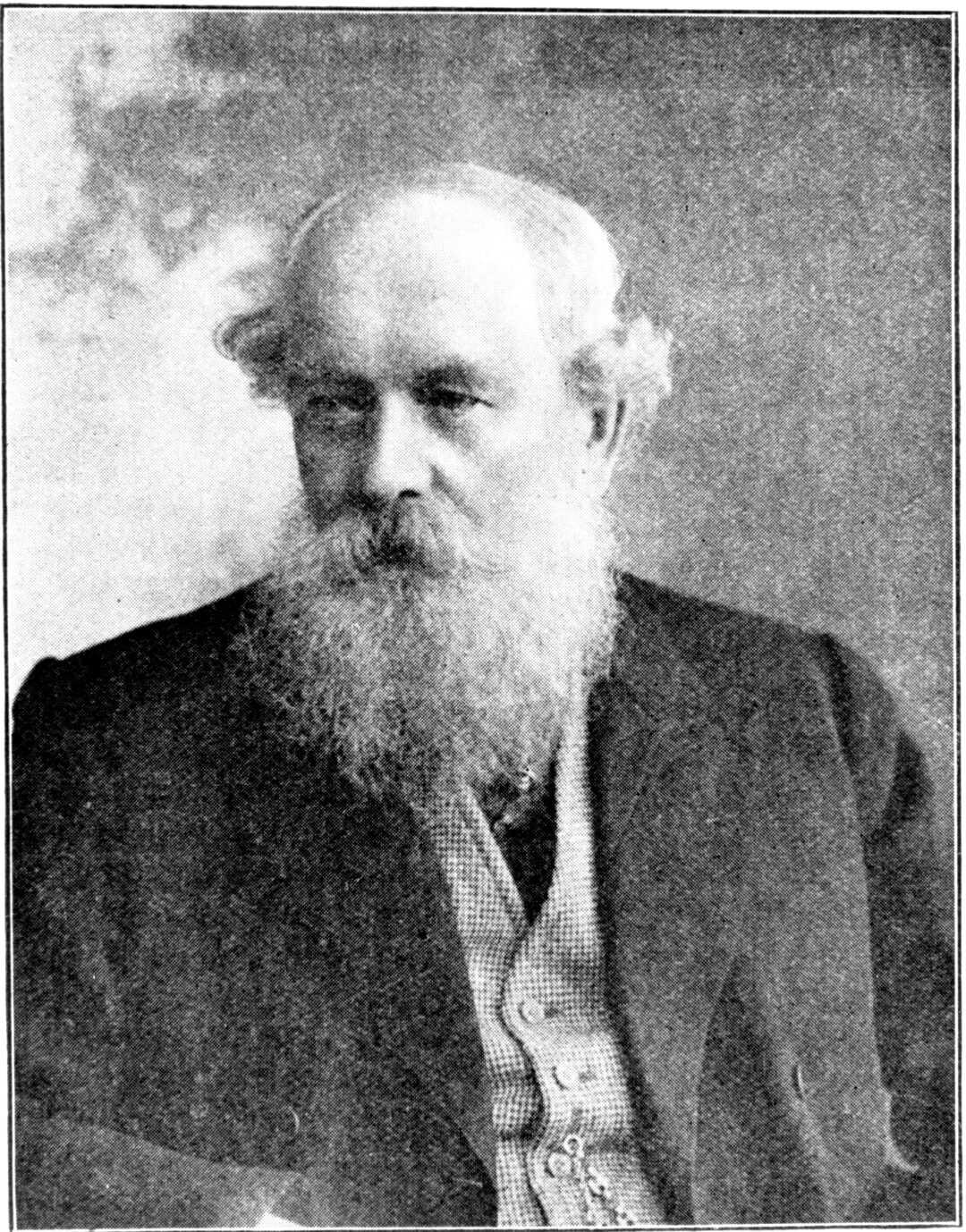
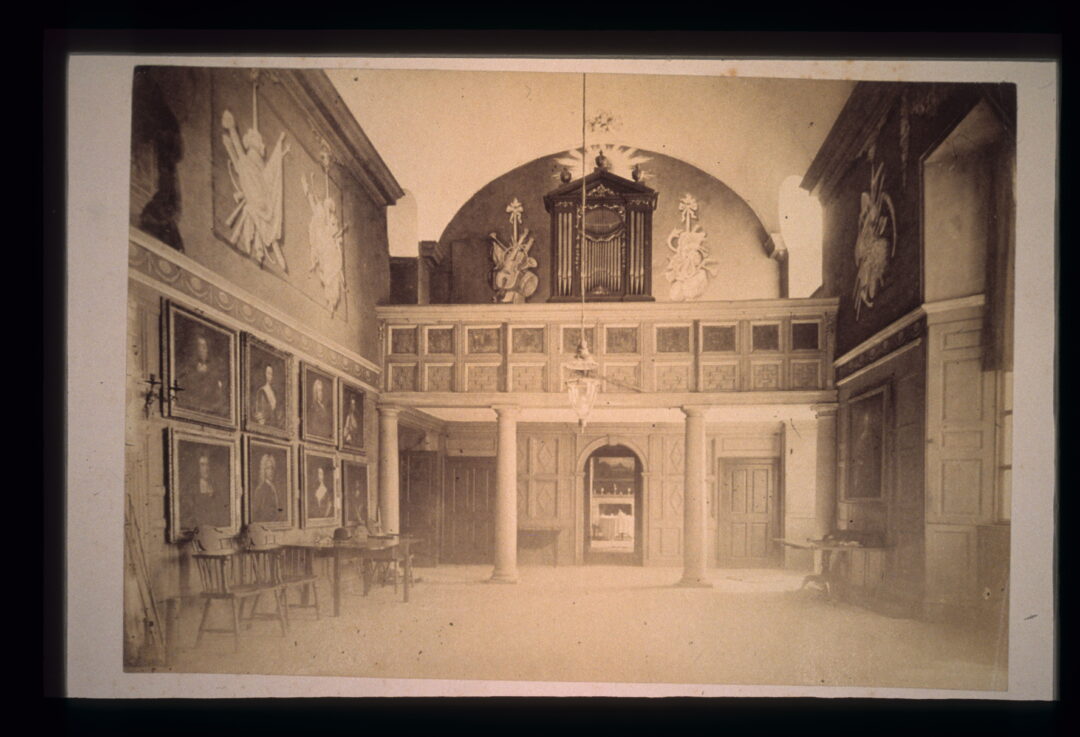
For reasons unknown, Henry Hall was dismissed after only a few months and his designs set aside in favour of new schemes by architect, surveyor and civil engineer, James Baker Green of Salisbury Street, Blandford Forum, Dorset. Little is known about James Green. Dorset born (Spetisbury) and a staff sergeant in the Dorset battalion, he seems to have worked mainly in the West Country and was currently being considered for the county surveyor position. Concurrent with the Hestercombe commission, Green was also working for Lord Portman on the Bryanston estate where he was overseeing the rebuilding of the Church of St. Peter, a 15th c. pile in the farming village of Pimperne. Regrettably, his changes to Hestercombe House 'destroyed many of those interesting features which his predecessor had thought it desirable to retain', leaving only the kitchen, dining room and morning room unaltered. To further complicate matters James Green died unexpectedly in March 1874, only a few months after works began, aged 43, from complications arising from pleurisy. He left behind a widow and six young children.

. . . it was thought desirable to retain for a time the works on the south side of the house, which had been executed according to Mr.Green’s plan, where are situated the morning-room and the principal domestic offices and which commands a delightful view of the vale of Taunton Deane and the Blackdown and other hills beyond. This front was originally very plain. Some architectural pretension has been attempted to be imparted to it, with the aid of cement and stucco, by the addition of new gables and parapets to the roofs and the raising of two towers, which stand on this side of the house, surmounting them with moulded cornices and open balustrade parapets. Suitable dressings and pilasters have been put to the windows, which have all been renewed with plate glass and new fittings.
‘The Majority of Mr. E. W. B. Portman’, Somerset County Gazette, 18 August 1877.
Henry Hall was eventually persuaded to return to Hestercombe but finding it impossible to recover the original profile and character of the House decided to prepare new designs for its completion. However, by 14 August 1877 – and the opening of the House on the occasion of Teddy Portman’s 21st birthday celebration -- these had only been partially carried out. ‘In contemplation to carry out at a future day’ was a new kitchen and other domestic work spaces on the east side while along the south front, which was kept much as James Green had left it, a new billiard room, conservatory and drawing room 60 feet long with projecting circular bay that united the old Column and Ante Rooms were deferred. A terrace garden much simplified from Henry Hall’s original proposal was laid out adjoining the south front by Lord Portman himself in July 1875. The west and north fronts were completely refashioned by Henry Hall in the Italian Villa style whilst a ‘Business Room’ was added to the northwest corner, forming a projecting wing with semi-octagonal bay, now a conference room. A new butler’s pantry, corridors, servant’s hall and other offices lay to the rear with access provided by a side entrance topped by a 100-foot high (30-metre) ‘picturesquely placed’ four-stage tower with Mansard roof and ornamental railings.

The main entrance to the House was now introduced by a new carriage porch with Tuscan columns, substantial cornice and parapet which fronted an entrance hall terminated by a grand oak staircase. The large gallery built overhead was intended ‘as a picture gallery, and for the exhibition of fossils and geological specimens’.
On the 14th of August 1877 celebrations were held at Hestercombe to mark coming-of-age celebrations of the 1st Viscount Portman's eldest grandson, the Hon. Edward William 'Teddy' Berkeley Portman. The total cost of Lord Portman’s four-year renovation and modernisation program, much of which was implemented by builder and general contractor, Henry Davis of Taunton, was now over £13,000 (£1,511,000 in today's money). Davis was best known for his work on area churches, including St Mary Magdalene, St. John's and St. George's in Taunton. The richly appointed interiors he completed at Hestercombe House featured Devonshire-coloured marble columns and encaustic tiles (Entrance Hall), wainscot oak and parquetry (Dining Room), wainscot pitch pine (Business Room), Devonshire marble Corinthian columns and pilasters (Grand Staircase & Gallery), and assorted moulded panels and pilasters (Dining Room, Staircase, and Gallery ceilings).
Fire was confined to the roof of the entrance hall, which had been in the hands of the builders undergoing some structural repairs . . . It is supposed that some cinders must have got under the hearthstone [in the bedroom above] and thus ignited the beams below.
‘Hestercombe: Fire at Lord Portman’s Seat’, Bridport News, 5 October 1894, p. 7
In 1892 William Henry Berkeley Portman, the second Viscount (1829-1919), presented Hestercombe House and estate to his oldest son, the Hon. Edward Berkeley Portman (1856-1911), following Teddy’s marriage in July to Constance Mary Vesey, the widow of Capt. the Hon. Eustace Vesey, 9th Lancers, and third daughter of the 2nd Baron Wenlock. Two years later on 6 December the couple moved to Hestercombe permanently from their rented residence at St. Giles, Dorset. The same year a Somerset County Gazette article confirmed that yet another phase in the refurbishment of Hestercombe House had begun:‘ . . . for some time past very extensive additions and improvements have been made . . . no fewer than 150 men have for some months been employed on the work and they are likely to be there for some time to come’. It is probable that the Gazette correspondent was referring to, at least in part, the addition of a new kitchen and other domestic offices on the east side of the House, as per Henry Hall's final (1876) design proposal. Henry James Spiller builder and contractor of Bridge Street, Taunton, a former Mayor of the town, was selected to carry out the work which also involved the redecoration of the House interiors. However, the project nearly met with disaster when, in the early hours of Wednesday 3 October 1894, a fire broke out in the large bedroom over the Entrance Hall. The blaze, which started in a fireplace lit to dry out the newly refurbished room, was only just contained due the quick action of the housekeeper who, awakened ‘to the sound of crackling’, alerted a number of workmen staying nearby. Thanks to a ready water supply from the pond fed reservoirs in the valley behind the House (and the excellent pressure which resulted from their elevated location), the workmen were eventually able to dowse the fire using a hose. ‘Great damage’ was, however, still done to the bedroom: ‘The whole of the beautiful decoration was, of course, completely destroyed as were also the wainscoting, the doors, the windows and a portion of the floor measuring about twenty feet by twelve.’ Together with smoke and water damage inflicted on the surrounding rooms, the completion of Henry Spiller’s works was set back by several months.
Not surprisingly, the changes effected to Hestercombe House by Lord Portman and his grandson, Teddy, from 1874 were not a critical success. Edwin Lutyens thought it ‘a very bad house architecturally’; Henry Avray Tipping, Architectural Editor of Country Life magazine 1907-33 agreed but was more forthcoming.
Of the house we need not say much. The eighteenth century work, which was fairly good of its age, has been added to and overlaid in a nineteenth century manner, and this was not done at a fortunate moment or by a happy hand. It is a most ample, comfortable and well-placed home, but architecturally and decoratively it is one of the many productions of the Victorian age, which we are beginning to look upon as examples to avoid rather than to copy. The chief feeling it excites is one of regret that it did not escape treatment at the time when it was done, in order that it might have come under the same guidance and within the same scheme as the new gardens. Their fine architecture emphasises the contrast rather strongly. The difference between house and garden is surely more one of shape and structure. It lies deeper. It is in the spirit and the essence. Whoever it was that altered the Bampfylde classic house was evidently one of that large class of Victorian architects who did not understand what style was and who lacked feeling both for either form and surface. It is uninformed and uninspired clerk’s work set out on the drawing board with mechanical correctness and constructive security.
Henry Avray Tipping, 'Hestercombe I. Somerset. The Seat of the Hon. Edward W. Berkeley Portman', Country Life Vol XXIV--No 614 (10 October 1908), p. 490.
